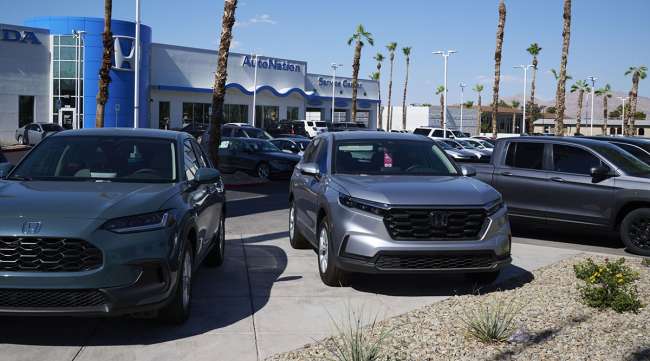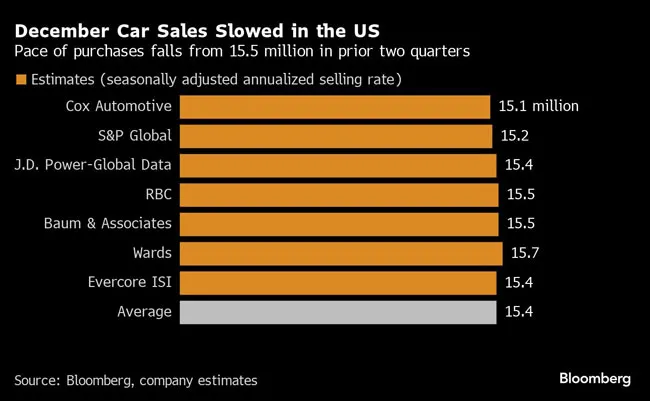Carmakers End 2023 With High Rates, Prices Affecting Sales

[Stay on top of transportation news: Get TTNews in your inbox.]
General Motors Co. and several other automakers reported slowing U.S. sales growth toward the end of last year while rival Toyota Motor Corp.’s volume remained strong, as near-record sticker prices and high interest rates led to uneven impacts across the auto market.
GM’s deliveries ticked up less than 1% in the fourth quarter, the company said Jan. 3, as the automaker recovered from United Auto Workers strikes at four assembly plants in the period. Nissan Motor Co. and Honda Motor Co. saw more sluggish growth at the end of the year, while Korean carmaker Kia America’s sales dipped in the latest quarter.
Pent-up demand that propped up sales in the wake of the pandemic has been sated, and some shoppers are now balking at 10% interest rates on car loans and average prices around $48,000. Overall sales likely slipped to a seasonally adjusted annual rate of about 15.4 million vehicles in the final month of 2023, down from about 15.5 million in the prior two quarters, according to estimates compiled by Bloomberg.
“We’ve seen a big reduction in median- and lower-income households” buying new cars, which now “almost exclusively go to the top 20% of income households,” Jonathan Smoke, chief economist for researcher Cox Automotive, said in an interview.
Still, there were pockets of resilience. Toyota’s deliveries rose more than 15% in the last three months of 2023, powered by growth from hybrid-electric vehicles. And South Korea’s Hyundai brand sales gained 5% in the period, marking a record, it said.
Toyota’s big gains came from its compact Corolla hybrid sedan, which more than doubled, and RAV4 small SUV, which rose 37% in the fourth quarter. The automaker attributed the strong showing to increased availability of product in the second half of the year as supply chain and logistical woes eased, and from product launches such as the Grand Highlander mid-size SUV.
“We hit our stride in the fourth quarter. We were able to get more of our new product out to the dealerships,” David Christ, head of the Toyota brand in the U.S., said in an interview.
For Hyundai Motor Co.’s eponymous brand, it was a gas guzzler and an electric vehicle that grew the most in sales, with deliveries of the large Palisade SUV and Ioniq 5 EV nearly doubling in the quarter.

GM’s sales rose just 0.3% in the quarter, with strikes at four plants cutting production of its top-selling Chevrolet Tahoe and GMC Yukon SUVs and high-volume Chevy Colorado pickups, among other models. The company finished the year with a strong December as inventory was replenished, a spokesman said. Despite the strike, GM’s sales rose 14% for the year.
The Detroit automaker continues to struggle with electric vehicle output. GM had targeted 150,000 deliveries last year but actually sold just under 76,000 EVs, with most of the volume coming from its Chevy Bolt compact plug-in — a model GM is discontinuing in its present form. Production issues have plagued the launch of vehicles made with the company’s Ultium battery.
Nissan’s 5.6% sales gain in the quarter marked a sharp slowdown from its full-year performance, which was up 23%. Deliveries of its Sentra compact sedan rose about 42% in both the final three months and for the year.
Overall sales decelerated at the start of the quarter and then picked up in December, Judy Wheeler, vice president of Nissan brand sales in the U.S,. said in an interview. A drop in interest rates would help ease financing costs and staunch growth in dealer lot inventories at many manufacturers.
“Interest rates are starting to come down now,” she said. “That will make a major difference for consumers because they will have a little more money in their pocket now.”
Kia America said sales fell slightly in the quarter to 60,275 even though its sales for the year hit a record 782,000.
Honda Motor Co.’s U.S. deliveries soared 31.5% in December, but that was below the automaker’s 33% pace of growth for the full year. It saw an 11.5% decline in sales of its signature Accord sedan, even as CR-V model deliveries jumped 88.2% — making it the best-selling crossover SUV on the market.
Want more news? Listen to today's daily briefing above or go here for more info
While 2023 was a big improvement over an inventory-constrained 2022, the challenges seen at the end of the year are expected to persist. Cox Automotive predicts U.S. auto sales will be up less than 2% in 2024. That means the figure is unlikely to top 17 million in annual vehicle sales anytime soon, as they did for five consecutive years before to the pandemic.
“The new norm for the industry because of reduced affordability is closer to 16 million,” Smoke said. “We’ve lost about 10% of the buying pool.”
Automakers aren’t motivated to cut prices because they’re making more money selling fewer cars. Consumer spending on new vehicles reached a record $578 billion in 2023, its third consecutive year exceeding a half-trillion dollars, according to researcher J.D. Power. Consumers’ average monthly car payment in December was estimated to be $739, up $9 from a year earlier, J.D. Power said.
Toyota executives say sticker price shock is forcing more car buyers to downsize when they trade-in, and some consumers are opting for late-model used cars instead of new. Even so, they expect the momentum to build toward 16 million in annualized sales into 2024 as vehicle availability improves and other brands boost incentive spending to spur demand.
“There’s a lot of optimism going into the year,” said Jack Hollis, Toyota Motor North America’s executive vice president.




